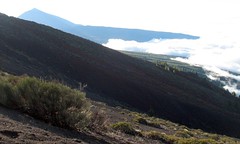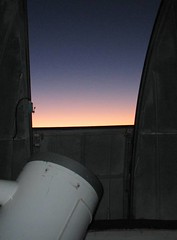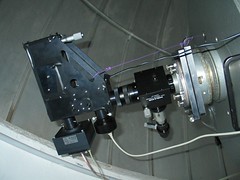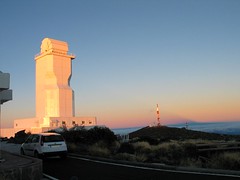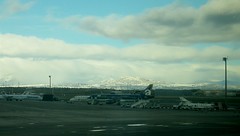Super evening: wind at 0Km/h, 50% humidity. Things looked promising for another night of measurements. Right after dusk, we took four 20-minute spectra of WR 140. We then closed the dome to make a few flatfield calibration frames, for the grating position used on the spectrograph. We had not done these calibration frames during the day, because we went shopping, as you can read on the previous post!
Humidity sneaked by while the dome was still closed, and we could not open it again for to measure more targets! Later, the humidity was replaced by strong wind, and cold temperatures came! Now, it's -4.7º outside ?!? Brrr..
What to do? Measure stuff about the camera's RBI (read the post about Residual Bulk Image), the sensor's undesireable elephant memory!
I will soon show what tests we made on the RBI problem.
Saturday, December 20, 2008
Day #5 (2008/12/19)
Today we woke up early (10:00), in result of last night's bad weather. Still, the observatory premises were once again inside a cloud! We decided to go down to a supermarket, in Chio, for shopping, 60km West and 1800m below.
The supermarket was known to be there waiting for us because of Google Earth! But well, 60km in these roads has to be made in 1 hour! So the trip to the supermarket, the gas station, and back took 2 hours. As a result, we were not in time to reserve the dinner at the cantina (deadline for that is 15:00). Next time, I will take the TF-24 road towards East, back to near La Laguna, where there is a vast Cash & Carry, with all sort of stuff!
We decided to have lunch on the restaurant in front of the detour to the observatory at El Portillo. The day's menu was eatable but not as tasty as it sounded. The canary cuisine seems to combine the expertise in condiments and the pragmatism of frozen meat... (Ok, so we are at 2200m, and the closest retailers are at La Orotava, through the "scenicly" slow TF-21 road; we should understand). But Thomas' steak au champignon was very appealing!
Enough sight-seeing and eating, we had to go back to the observatory for preparatory work!
The supermarket was known to be there waiting for us because of Google Earth! But well, 60km in these roads has to be made in 1 hour! So the trip to the supermarket, the gas station, and back took 2 hours. As a result, we were not in time to reserve the dinner at the cantina (deadline for that is 15:00). Next time, I will take the TF-24 road towards East, back to near La Laguna, where there is a vast Cash & Carry, with all sort of stuff!
We decided to have lunch on the restaurant in front of the detour to the observatory at El Portillo. The day's menu was eatable but not as tasty as it sounded. The canary cuisine seems to combine the expertise in condiments and the pragmatism of frozen meat... (Ok, so we are at 2200m, and the closest retailers are at La Orotava, through the "scenicly" slow TF-21 road; we should understand). But Thomas' steak au champignon was very appealing!
Enough sight-seeing and eating, we had to go back to the observatory for preparatory work!
Friday, December 19, 2008
Night #4 /2008/12/18)
Waking up at 12:00 (again), going for lunch, coming back for plat fields, trying to solve the "Neon problem" (Residual Bulk Image), a few mails, a few phone calls, a few tests...
We finally settler for doing some quick darks and bias frames to try and minimize the problem. But this CCD really likes memorizing Ne lines.. It takes time to forget them!
Meanwhile, we decided to tackle the issue of the not-so-good-looking flatfields we were making. We had an intense gradient, and wavy look on our "flats". Later we were reminded that the sensor's sensitivity is it self wavy in aspect. Since a spectrograph physically distributes wavelength on the sensor, it is natural that that something constant is detected by the sensor as darker or brighter in agreement with its sensitivity. The other gradient we have is still unclear in origin. But since a spectrum is only a band of a handful of pixels wide, it doesn't matter! Images that are reduced to produce spectra don't need to be pretty, as noone usually is interested in seeing them.. It is more important that the flat can correctly correct the data, and for that purpose, it works as expected!
During the night, we made 4 20-minute measurements of WR 140, spent some training time trying to point at WR 1, and then 2 more measurements of HD 14134. But we were unexpectedly and abruptly interrupted by a "100% humidity" smell inside the dome! In 20 minutes, humidity had risen from 45% to 100% outside.. We were forced to close the dome, before outside temperature would reach -2.1ºC (dew point at -1.6ºC). These temperatures explain how our car got covered in a bubbly spray of ice! Quite interesting to the touch, but very uncomfortable to stay outside touching it in the cold wind.
Well, a side-effect of this "unfavorable" weather, is that the cumulative 8 hours we had of sleep in the past two mornings, were finally going to be payed back between our pillows and our warm sheets!
Our elephant-memory sensor was left powered on, making dark and bias exposures, during our night of sleep...
Well, I did dedicate part of my sleep time to write the recent posts that should have been written from two days ago..
We finally settler for doing some quick darks and bias frames to try and minimize the problem. But this CCD really likes memorizing Ne lines.. It takes time to forget them!
Meanwhile, we decided to tackle the issue of the not-so-good-looking flatfields we were making. We had an intense gradient, and wavy look on our "flats". Later we were reminded that the sensor's sensitivity is it self wavy in aspect. Since a spectrograph physically distributes wavelength on the sensor, it is natural that that something constant is detected by the sensor as darker or brighter in agreement with its sensitivity. The other gradient we have is still unclear in origin. But since a spectrum is only a band of a handful of pixels wide, it doesn't matter! Images that are reduced to produce spectra don't need to be pretty, as noone usually is interested in seeing them.. It is more important that the flat can correctly correct the data, and for that purpose, it works as expected!
During the night, we made 4 20-minute measurements of WR 140, spent some training time trying to point at WR 1, and then 2 more measurements of HD 14134. But we were unexpectedly and abruptly interrupted by a "100% humidity" smell inside the dome! In 20 minutes, humidity had risen from 45% to 100% outside.. We were forced to close the dome, before outside temperature would reach -2.1ºC (dew point at -1.6ºC). These temperatures explain how our car got covered in a bubbly spray of ice! Quite interesting to the touch, but very uncomfortable to stay outside touching it in the cold wind.
Well, a side-effect of this "unfavorable" weather, is that the cumulative 8 hours we had of sleep in the past two mornings, were finally going to be payed back between our pillows and our warm sheets!
Our elephant-memory sensor was left powered on, making dark and bias exposures, during our night of sleep...
Well, I did dedicate part of my sleep time to write the recent posts that should have been written from two days ago..
Night #3 (2008/12/17)
The "day" started as we left bed, around 12:00. That means 4 hours of sleep, while the CCD camera was left making dark exposures. We started by taking calibration flatfields for the end of the previous night (for the corresponding spectral range), and then made the same stuff for the begining of the night to come (different spectral range).
Our nights are broken in two parts: WR140 observation, with wavelengths around the bnlue-green area (grating position on 9.3 micron), and the H-alpha region for all other targets (grating position at 10.5 micron).
The night was great! Humidity had given us a break for the second consecutive night!
We pointed to some targets and made some spectra of them, but they were not many. We stumbled across a problem: Some images were superimposed with strange emission lines! We spent a lot of time debugging the problem, from over-taping the spectrograph with opaque anti-lightleak adesive stuff, to carefully putting a black bag around the spectrograph and then wrapping it in a double black bag (those used for storing garbage). We then identified the emission lines as those from the calibration lamp, and took the power plug out, to make sure no photon was comming out of the lamp.
The problem would only be correctly identified at the end of the night: RBI (Residual Bulk Image). To make it short the CCD memorizes strong information from the previous integration it made, and also adds it to the next integration. A problem for which we knew not how to choose among solutions. Thos would only be attempted on the next day/night...
Our nights are broken in two parts: WR140 observation, with wavelengths around the bnlue-green area (grating position on 9.3 micron), and the H-alpha region for all other targets (grating position at 10.5 micron).
The night was great! Humidity had given us a break for the second consecutive night!
We pointed to some targets and made some spectra of them, but they were not many. We stumbled across a problem: Some images were superimposed with strange emission lines! We spent a lot of time debugging the problem, from over-taping the spectrograph with opaque anti-lightleak adesive stuff, to carefully putting a black bag around the spectrograph and then wrapping it in a double black bag (those used for storing garbage). We then identified the emission lines as those from the calibration lamp, and took the power plug out, to make sure no photon was comming out of the lamp.
The problem would only be correctly identified at the end of the night: RBI (Residual Bulk Image). To make it short the CCD memorizes strong information from the previous integration it made, and also adds it to the next integration. A problem for which we knew not how to choose among solutions. Thos would only be attempted on the next day/night...
TASCS
 The Astronomer Specialized Cleaning System.
The Astronomer Specialized Cleaning System.Our bathroom has a specialized showering system, where the astronomer stands inside a tiny 60x60 cm2 white tub. Half of it is enclosed by 2 cold fixed walls, the other half is delimited by cold flexible colored cloth. Cloth flexibility allows the transit of the astronomer to the interior of the showering chamber. Water temperature is adjusted via a two-knob interface, and is highly susceptible the the astronomer's dexterity in temperature-combination of water. The left know controls the amount of really HOT water, and the left one adjusts the flow of freezing cold water.
The Zen balance between the rotation of both knobs thus yields a pleasant water temperature. Water too hot, burns; water too warm, creates convection air currents that affect the position on the cold wet flexible cloth surrounding the chamber and reducing its usable volume.
On the other hand, water too cold is not preferable to getting stuck on the wet cloth!
The astronomer's bath is thus a daily challenge for which patience and balance should be mastered.
End of night #2 (2008/12/16)
Ah!.. The day rises on the other side of the magical dome window..
A thundery acoustic echoes inside the hemispherical dome, coming from the ceiling motor closing the slit from above.. This scary sound, pumps caffeine through our ears, and unexpectedly contributes to the magic of the birth of a new day.. One which feels strange for those who did not slept its preceding night period. The slowness of the day's birth, the laziness of the slit closing, and the lethargic dimming of the light inside the dome, form the most complex sensation one can have in thw presence of such strange melody..
A thundery acoustic echoes inside the hemispherical dome, coming from the ceiling motor closing the slit from above.. This scary sound, pumps caffeine through our ears, and unexpectedly contributes to the magic of the birth of a new day.. One which feels strange for those who did not slept its preceding night period. The slowness of the day's birth, the laziness of the slit closing, and the lethargic dimming of the light inside the dome, form the most complex sensation one can have in thw presence of such strange melody..
Tuesday, December 16, 2008
Spectrograph at the MONS
Tuesday, 16th of December, after lunch : The humidity today as dropped beautifully! If fell from 100% to 48.8% in a about one hour. So we headed to the observatory, and we are now taking dark frames, in preparation for tonight! Next we should open the dome to search for Venus, for practicing pointing, and to finalize adjustments on the CCD camera and focusing/collimating doublet. Here is an image of all the setup!
First official night of team #2 (2008/12/15)
100% humidity! (And it still is!)
We did not even go to the observatory, and staied at our house, waiting for humidity to go down, in hope that we could go finish setting up the camera, and practice telescope-pointing. But humidity has been at 100% for the last 56 hours!
So not being able to use the telescope, we started drafting our observation plans!
Each target will take about 2 hours of acquisition. WR140 is in Cygnus, and sets early in the night. This means it must be the first target as soon as it is "dark". Next, we have Oe stars to look at. HD14134, in Perseus, will be the next target. Then we should follow the order they come up the sky, for the remainder 3 targets, in order not to flip the equatorial mount. We must also not forget two teluric stars for getting a measure of the continuum to be able to calculate a response function of our equipment. Then there is the callibration frames we need (Neon spectra, Flats, Darks and Bias)
So we are expecting to start working before dinner taking all sort of pointing-independant callibration images, then some spectra of WR140 while having dinner, not forgetting callibration Neon spectra images, then the other targets. Let's hope tonight is a good night.
We did not even go to the observatory, and staied at our house, waiting for humidity to go down, in hope that we could go finish setting up the camera, and practice telescope-pointing. But humidity has been at 100% for the last 56 hours!
So not being able to use the telescope, we started drafting our observation plans!
Each target will take about 2 hours of acquisition. WR140 is in Cygnus, and sets early in the night. This means it must be the first target as soon as it is "dark". Next, we have Oe stars to look at. HD14134, in Perseus, will be the next target. Then we should follow the order they come up the sky, for the remainder 3 targets, in order not to flip the equatorial mount. We must also not forget two teluric stars for getting a measure of the continuum to be able to calculate a response function of our equipment. Then there is the callibration frames we need (Neon spectra, Flats, Darks and Bias)
So we are expecting to start working before dinner taking all sort of pointing-independant callibration images, then some spectra of WR140 while having dinner, not forgetting callibration Neon spectra images, then the other targets. Let's hope tonight is a good night.
Monday, December 15, 2008
The Second Team Arrived
Sunday, 14th, the second team (Thomas and me) is complete at the MONS observatory, having met the first team there (Lothar and Berthold). After witnessing the shadow of Teide rising over the atmosphere, we headed to the MONS observatory. There we learned how the telescope is controlled, and all sort of introductory stuff. It was a day and night of "handing over" the information from team 1 to team 2. High humidity forced us to close the dome. Meanwhile we changed CCDs, from the observatory camera (parallel SBIG ST-8) to the faster Sigma 1603ME. On the next decent night we will check the perpendicularity of the sensor to the optical path, fine-tune the position of the spectrograph's collimator, and leave the camera and spectrograph ready for acquisition. If everything goes according to plan, we should next attempt to point the spectrograph to WR140.
The evening now is not looking promising.. We are inside the clouds, and naturally, humidity is 100%, as there is no higher value to explain the term "condensed humidity" :)
You can see how the weather is at this instant, on the site of the observatory weather station.
The evening now is not looking promising.. We are inside the clouds, and naturally, humidity is 100%, as there is no higher value to explain the term "condensed humidity" :)
You can see how the weather is at this instant, on the site of the observatory weather station.
From 16F
As warned in the previous post, the next time I would write something more could be during flight! Indeed I originally wrote this on a small note book, and later transferred it in Madrid to my notebook, or laptop ;)
But forget that I am now typing in Barajas airport, and read on as if still in Lisbon, inside the airplane!
16F is my seat in the airplane. "F" meaning "Fabulous views" or "stibord window seat". Outside you can see the KLM flight for which the loudspeakers at the airport were insistingly calling for the two Portuguese-named passengers (Filipe and Sebo) destined to Frankfurt. It is one of those sights that you tend to imagine you only see in Portugal: The KLM plane was moving backwards, away from the gate and, in doing, so causing a traffic jam, of two small luggage carriers, one bus, two vans, and a larger luggage truck.. There were no traffic lights, and the road vehicles were coming from the right, and an airplane was moving backwards! The situation looks a bit more comic at 7:00 am when you have slept very little...
.. Any way, soon it was our turn to cause traffic jams and take off.
The silhouette of clouds in the distance begin glowing a metallic hot tone, that very slowly spreads to neighboring cloud tops. This goes on until the bright shine becomes uncomfortable, just seconds before a confident reddish shine clearly denounces the sun!
In flight, the sun rises at 7:32.. Just 5 minutes later, breakfast arrives as we cross the border into Spain.
The tops of clouds below the aircraft receive the first direct sun light only at 7:42!
I don't understand why people would say bad things about TAP airplane food.. I got a ham sandwich overcrowded with cheese, accompanied by Tea/Coffee, orange/apple juice and strawberry yogurt! All this takes 10 minutes to eat. And at 7:51 we were already starting our descent to Madrid airport. The flight from Lisbon to Madrid is a restaurant! You seat, you eat, and you leave.. Of course, I had to pay almost 100 euros for such a luxurious breakfast with fascinating views through a non-luxuriously dirtied window..
But it strikes curiosity in imagining that we are already descending to Madrid when the sun has not yet risen in Lisbon.
Here, near Toledo, you can see the fields lit by shallow warm sunlight, with some occasional specular reflections from some house roofs.. Solar panels, perhaps? We are descending at 2 meters per second, estimating from the screens..
Oh well... Spaniards are strange people, with a strange landscape.. Now you can see white sand, and roads also in a whitish tone.. What a strange sight! Why would you they build roads in such a colour?.. Would it be under construction still? But then everything starts turning white.. Some trees now get white too!.. What?!?
IT'S SNOW!!! It snowed near Madrid!! Now I understand why I saw a river that was white before a small dam, and watery in aspect after it! It makes sense with the temperature outside the airplane of -13º (3º at Madrid, as our female commander announced)
What a spectacular sight! SNOW!!! Snow!! snow!... What a joy!
As the plane moves, the ground now becomes less snowy, interpolating itself back into the normal vegetationish look.. Trees become darker, followed by snow and ice turning into dew, and then into a clean washed look, and then to dry areas..
What an unforgettable trip this is starting to be
But forget that I am now typing in Barajas airport, and read on as if still in Lisbon, inside the airplane!
16F is my seat in the airplane. "F" meaning "Fabulous views" or "stibord window seat". Outside you can see the KLM flight for which the loudspeakers at the airport were insistingly calling for the two Portuguese-named passengers (Filipe and Sebo) destined to Frankfurt. It is one of those sights that you tend to imagine you only see in Portugal: The KLM plane was moving backwards, away from the gate and, in doing, so causing a traffic jam, of two small luggage carriers, one bus, two vans, and a larger luggage truck.. There were no traffic lights, and the road vehicles were coming from the right, and an airplane was moving backwards! The situation looks a bit more comic at 7:00 am when you have slept very little...
.. Any way, soon it was our turn to cause traffic jams and take off.
The silhouette of clouds in the distance begin glowing a metallic hot tone, that very slowly spreads to neighboring cloud tops. This goes on until the bright shine becomes uncomfortable, just seconds before a confident reddish shine clearly denounces the sun!
In flight, the sun rises at 7:32.. Just 5 minutes later, breakfast arrives as we cross the border into Spain.
The tops of clouds below the aircraft receive the first direct sun light only at 7:42!
I don't understand why people would say bad things about TAP airplane food.. I got a ham sandwich overcrowded with cheese, accompanied by Tea/Coffee, orange/apple juice and strawberry yogurt! All this takes 10 minutes to eat. And at 7:51 we were already starting our descent to Madrid airport. The flight from Lisbon to Madrid is a restaurant! You seat, you eat, and you leave.. Of course, I had to pay almost 100 euros for such a luxurious breakfast with fascinating views through a non-luxuriously dirtied window..
But it strikes curiosity in imagining that we are already descending to Madrid when the sun has not yet risen in Lisbon.
Here, near Toledo, you can see the fields lit by shallow warm sunlight, with some occasional specular reflections from some house roofs.. Solar panels, perhaps? We are descending at 2 meters per second, estimating from the screens..
Oh well... Spaniards are strange people, with a strange landscape.. Now you can see white sand, and roads also in a whitish tone.. What a strange sight! Why would you they build roads in such a colour?.. Would it be under construction still? But then everything starts turning white.. Some trees now get white too!.. What?!?
IT'S SNOW!!! It snowed near Madrid!! Now I understand why I saw a river that was white before a small dam, and watery in aspect after it! It makes sense with the temperature outside the airplane of -13º (3º at Madrid, as our female commander announced)
What a spectacular sight! SNOW!!! Snow!! snow!... What a joy!
As the plane moves, the ground now becomes less snowy, interpolating itself back into the normal vegetationish look.. Trees become darker, followed by snow and ice turning into dew, and then into a clean washed look, and then to dry areas..
What an unforgettable trip this is starting to be
Subscribe to:
Comments (Atom)
